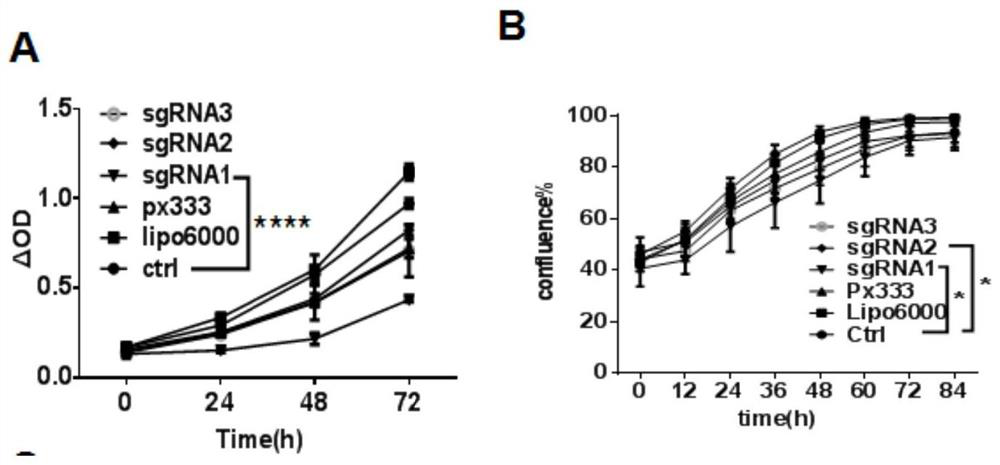Application of stat3, hbx, stat3-hbx targeting CRISPR/Cas carrier in the preparation of HBV-related liver cancer drugs
A carrier and targeting technology, applied in the field of genetic engineering, can solve problems such as unsolved problems, and achieve the effect of promoting cell apoptosis, reducing expression, and promoting cell apoptosis
- Summary
- Abstract
- Description
- Claims
- Application Information
AI Technical Summary
Problems solved by technology
Method used
Image
Examples
Embodiment 1
[0094] Example 1: Construction of single-function silencing vectors targeting Stat3 and HBx respectively
[0095] Select the PX333 vector, digest it with BsaⅠ, and recover the linear fragment through agarose gel. According to the design strategy of CRISPR / Cas9 sgRNA, design 3 sgRNAs for the second and eighth exons of Stat3; for the gene sequence of HBx Design 2 sgRNAs (Table 1). The sgRNA fragments were annealed, ligated with the recovered fragments of the PX333 vector by T4 ligase, transformed into competent cells, and single clones were selected for sequencing. Sequencing results showed that 3 kinds of monofunctional plasmids targeting Stat3 and 2 kinds of targeting HBx were successfully constructed.
[0096] Table 1: sgRNA information
[0097]
[0098]
Embodiment 2
[0099] Example 2: Screening of a single-function silencing vector targeting Stat3
[0100] (1) Both Stat3-sgRNA1 and Stat3-sgRNA2 can reduce the expression of Stat3 protein
[0101] Experimental method: HepG2.2.15 cells use liposome Lipo6000 as a transfection reagent, set ctrl control, lipo6000 control (transfection reagent only), PX333 (vector control), and three plasmid vectors constructed to silence stat3, transfect After 48 hours of staining, the protein was extracted and detected by Western Blot.
[0102] Result: as attached figure 2 As shown, the results show that targeting both Stat3-sgRNA1 and sgRNA2 sequences can reduce the expression of Stat3 protein.
[0103] (2) Stat3-sgRNA1 and Stat3-sgRNA2 inhibit the proliferation of HepG2.2.15 cells
[0104] Methods: MTT and living cell monitor were used to study the proliferation of HepG2.2.15 cells after transfection of Stat3 plasmid.
[0105] Results: MTT results showed that targeting the Stat3-sgRNA1 sequence could inhib...
Embodiment 3
[0131] Example 3: Screening of HBx-targeting monofunctional silencing vectors
[0132] HBx-sgRNA2 inhibits the expression of HBx protein
[0133] Method: HepG2.2.15 cells use liposome Lipo6000 as transfection reagent, set ctrl control, lipo6000 control (transfection reagent only), PX333 (vector control), and two plasmid vectors constructed to silence HBx, and transfect After 48 hours, the protein was extracted, and the expression of HBx, p-Stat3, and Stat3 proteins were detected by Western Blot. The results are shown in the attached Figure 8 shown.
PUM
 Login to View More
Login to View More Abstract
Description
Claims
Application Information
 Login to View More
Login to View More - R&D
- Intellectual Property
- Life Sciences
- Materials
- Tech Scout
- Unparalleled Data Quality
- Higher Quality Content
- 60% Fewer Hallucinations
Browse by: Latest US Patents, China's latest patents, Technical Efficacy Thesaurus, Application Domain, Technology Topic, Popular Technical Reports.
© 2025 PatSnap. All rights reserved.Legal|Privacy policy|Modern Slavery Act Transparency Statement|Sitemap|About US| Contact US: help@patsnap.com



